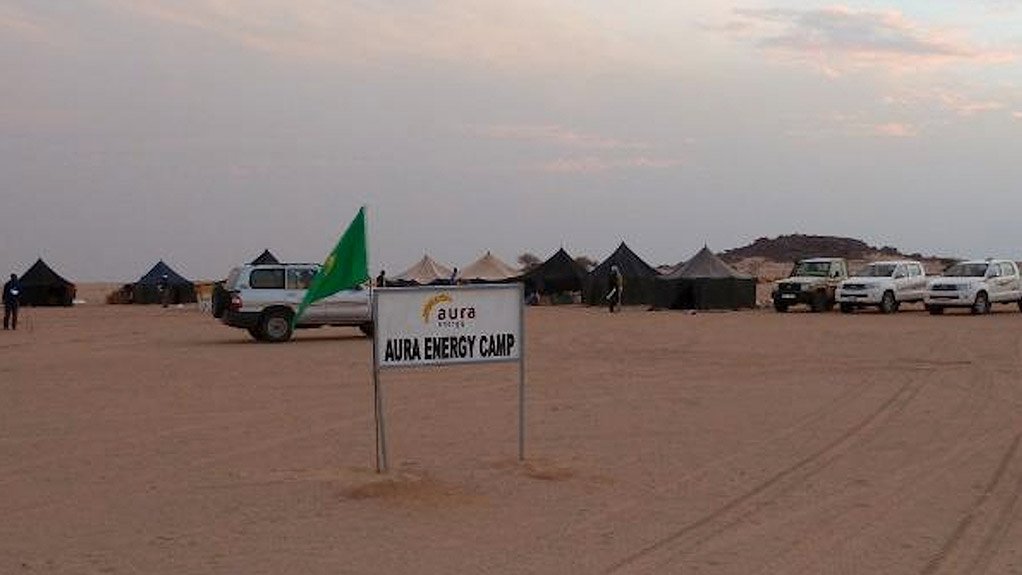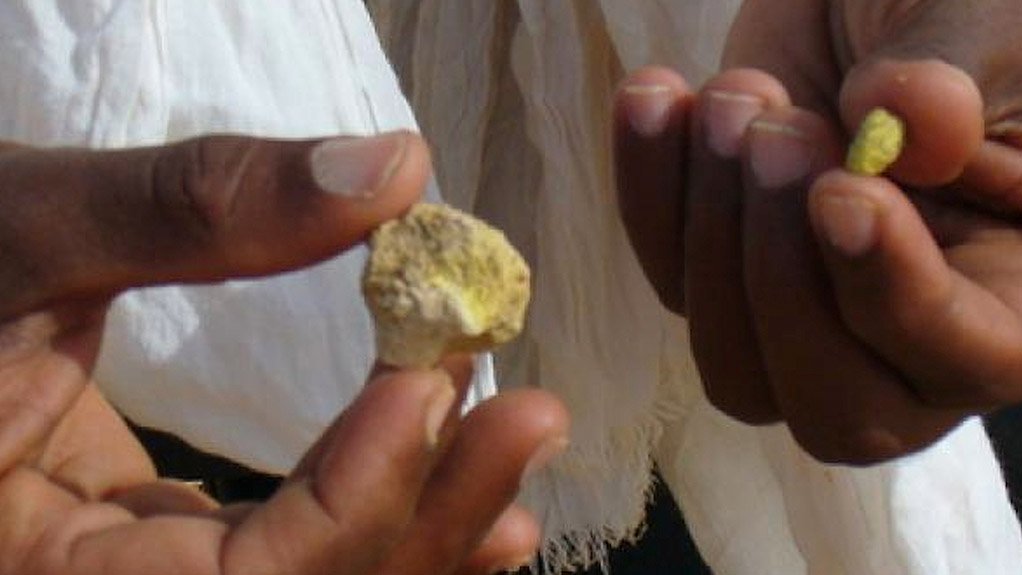Study highlights areas of high-grade mineralisation at Mauritania uranium prospect



DELAYED DEVELOPMENT Aura Energy’s development plans have been delayed, owing to the difficulty in accessing capital
RICH PICKINGS Most of the mineralisation at the project site occurs in a single sheet within four metres of the surface
ASX-listed uranium developer Aura Energy MD Dr Bob Beeson tells Mining Weekly that a recently completed scoping study of its Reguibat uranium project, at the Reguibat Craton, in northern Mauritania, highlighted the presence of several areas of high-grade mineralisation.
He states that, in conjunction with the strong beneficiation upgrade, the initial leach grades will be “exceptionally” high, driving strong early cash flow for the project.
Further, Beeson notes that Aura received leach test results in October last year, which indicated that uranium can be readily extracted from the concentrate in a short time.
“Aura is not aware of a uranium project of this type that has faster leach characteristics,” he enthuses. However, Beeson says Aura’s development plans have been delayed, owing to the difficulty in accessing capital.
Beeson explains that once sufficient capital has been raised and mining operations start at Reguibat, the process will be “straightforward”, as most of the mineralisation at the project site occurs in a single sheet within four metres of the surface.
“Individual sheets of mineralisation are up to 4 km in length and 700 m in width. The material is soft and friable, and can be readily dug by scrapers and shovels,” he states, adding that the project is expected to have a significantly low strip ratio of 0.2 to 0.3.
The life-of-mine is estimated at 15 to 30 years.
Beeson highlights that beneficiation upgrade test results for Reguibat indicate that more than 89% of the mass is rejected, while retaining 86% of the uranium.
“This represents a 700% increase in the grade of the samples tested to 2 500 parts per million, or 0.25% triuranium octoxide,” he notes, adding that this beneficiated grade increase is achieved using regular scrubbing and screening processes.
Beeson highlights that the presence of uranium carnotite in the fine fractions, and the difference in grain size between carnotite and the host rock materials, explains the positive beneficiation results Aura has received to date.
“There is also potential that this size difference may result in even higher grade products by refinement of the size fractioning,” he adds.
Preliminary leach testwork of beneficiated Reguibat project material achieved 94% uranium extraction within four hours.
“This compares favourably with, for example, the 92% extraction at uranium miner Paladin Energy’s Langer Heinrich uranium mine, in Namibia,” states Beeson, who attributes these high extraction levels to the very fine-grained nature of the uranium mineralisation at Reguibat.
He says simple atmospheric alkaline leaching has been selected as the most likely leaching route, based on previous diagnostic leaching testwork.
“Testwork suggests acceptable levels of reagent consumption, given the high grade of the beneficiated feed material.”
Beeson explains that the impact of the beneficiation on reducing the size of the leaching and precipitation parts of the extraction circuit will have a significant impact on the size of the plant, thereby reducing costs.
Further, he points out that a smaller-than-expected leach plant will significantly reduce water requirements, and Aura will also ensure that recycling of water is undertaken in an “optimally efficient manner”.
Aura has contracted global environmental engineering consulting firm Golder Associates to complete a study of available water supplies, owing to the company’s “extensive experience and working knowledge” of Mauritania.
Beeson highlights that global mining and commodity trading company Glencore recently approved a $900-million capital investment for the development of the Askaf iron-ore project, in northern Mauritania.
“The Glencore investment is significant for Aura, as Askaf lies within the Tiris Zemmour region of Mauritania, where the Reguibat project is also located,” he states.
Beeson adds that Glencore’s commitment is a strong validation of Mauritania being a sound jurisdiction for mining investment and mirrors Aura’s confidence in the country.
According to the 2013 Fraser Institute Survey – which measures and studies the impact of competitive markets and government interventions on individuals and society – Mauritania ranked fourth among African countries as a jurisdiction favourably geared toward mining investment.
Foreign-owned mining companies, such as First Quantum and Kinross, have had successful operations in Mauritania for many years and permission for the granting of mining licences only takes place after a regulated, transparent and reliable process.
“In Mauritania, government regards mining as a means of alleviating poverty and is extremely welcoming of potential miners. There are no local communities in the area surrounding the Reguibat project, but a new mining project will have a significant impact throughout the country, employing hundreds of people directly and indirectly,” Beeson concludes.
Comments
Press Office
Announcements
What's On
Subscribe to improve your user experience...
Option 1 (equivalent of R125 a month):
Receive a weekly copy of Creamer Media's Engineering News & Mining Weekly magazine
(print copy for those in South Africa and e-magazine for those outside of South Africa)
Receive daily email newsletters
Access to full search results
Access archive of magazine back copies
Access to Projects in Progress
Access to ONE Research Report of your choice in PDF format
Option 2 (equivalent of R375 a month):
All benefits from Option 1
PLUS
Access to Creamer Media's Research Channel Africa for ALL Research Reports, in PDF format, on various industrial and mining sectors
including Electricity; Water; Energy Transition; Hydrogen; Roads, Rail and Ports; Coal; Gold; Platinum; Battery Metals; etc.
Already a subscriber?
Forgotten your password?
Receive weekly copy of Creamer Media's Engineering News & Mining Weekly magazine (print copy for those in South Africa and e-magazine for those outside of South Africa)
➕
Recieve daily email newsletters
➕
Access to full search results
➕
Access archive of magazine back copies
➕
Access to Projects in Progress
➕
Access to ONE Research Report of your choice in PDF format
RESEARCH CHANNEL AFRICA
R4500 (equivalent of R375 a month)
SUBSCRIBEAll benefits from Option 1
➕
Access to Creamer Media's Research Channel Africa for ALL Research Reports on various industrial and mining sectors, in PDF format, including on:
Electricity
➕
Water
➕
Energy Transition
➕
Hydrogen
➕
Roads, Rail and Ports
➕
Coal
➕
Gold
➕
Platinum
➕
Battery Metals
➕
etc.
Receive all benefits from Option 1 or Option 2 delivered to numerous people at your company
➕
Multiple User names and Passwords for simultaneous log-ins
➕
Intranet integration access to all in your organisation




















